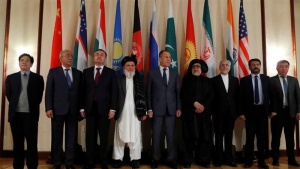Image Courtesy of Evan Vucci/AP
America has always been the land of the free, a place where people from all backgrounds can come and make a better life for themselves and experience the American dream. That is unless you’re of Hispanic or Middle Eastern descent. Prejudice towards Hispanics and Middle Easterners has always been a part of the US, but ever since Trump began his campaign based around his ‘Make America Great Again’ slogan and targeted these two groups the prejudice has been more prevalent than ever before. His campaign rhetoric – which stressed building a wall to block Mexicans who were “rapists and drug dealers” – has been his supporters’ justification for tensions between Hispanic immigrants and US citizens. Trump also installed the infamous Muslim ban as his first executive order, which halted immigration from certain Muslim-majority countries. This also led to an increase in hate and discrimination after the ban was installed. This propaganda from America’s highest office has served as ammunition for many domestic terror attacks and hate crimes against these communities.
Many Americans may wonder where this unjustified disgust for Latin Americans comes from. Leo Chavez suggests something called the Latino Threat Narrative (LTN) in his book The Latino Threat. The LTN serves as the justification for Trump’s anti-Latino policies. It is broken down into three parts. The first part is Invasion. The Invasion part of the LTN treats Latinos as invaders of the US who are here to take what Americans have. It also warns that if Latinos continue to have children the increase in American’s Latino population will make the US lose its sense of identity as a country.
The next part of the LTN is the idea of Reconquest. This idea arises from the aftermath of the Mexican-American War in which Mexico lost a large part of what is now the American southwest north of present-day Mexico to the US. The LTN advances the belief that Latinos – specifically Mexicans – aim to take back the land lost in the war. Author Samuel Huntington believes that this reconquest is already underway in the Southwest United States.
The last part of the LTN is the Quebec Model, which stresses that Latino immigrants are not here to assimilate into American culture but will instead try to form their own country along the lines of how Quebec operates. This logic that inspires the LTN has led to an increase in discrimination and even domestic terrorism against the Latino community. Many white supremacists have used Trump’s rhetoric to convince themselves they are saviors of the white race against invaders. Studies show that crimes against the Latino community have jumped exponentially since 2010. Trump has associated certain negative language with Latinos such as caravan and migrants. A user on 4chan, a chat room for conspiracy theorists and the alt-right stated that, “when he hears the word caravan he reaches for his gun”. Daryl Johnson, a former analyst on domestic terrorism stated that, “The rhetoric coming out of the White House is giving people license to target these people”. An example was the hate crime committed against Rodolfo Rodriguez, a 91 year old man who was attacked by a woman in California with a brick. Many believe that he was targeted due to his Hispanic heritage. In fact, in California alone there has been a 50 percent increase in hate crimes since 2016, when Trump was elected.
Ever since 9/11, Islamophobia has been rampant in the US. Many Muslims were targeted after the events just because they were Muslim. Fast forward 18 years and not much has changed. In fact, actions by the president such as the Muslim Ban have further perpetuated Islamophobia. Many Muslim Americans have been subjected to extra surveillance and law enforcement in their neighborhoods and near mosques for years. The media has continued this pattern of associating Muslims with danger. A study from the University of Alabama stated that terror attacks by Muslims receive 357% more attention from US news outlets than acts committed by non-Muslims. This equates to about 105 headlines about Muslim terror acts compared to 15 about non-Muslim terror acts. This is especially interesting because white and far right extremists have committed twice as many terror attacks as Muslims between 2008-2016. In 2018, a trio of right wing extremists from Kansas were arrested in connection to a plot to bomb Muslim refugees living in an industrial area. Luckily the plot was foiled before they could commit the attack. Another potential domestic terror attack against a Muslim community was stopped in Islamberg, a Muslim community in Delaware County. Three extremists were charged with conspiracy to commit terror after three homemade bombs and 23 firearms were recovered. These are just a few of the plots to kill Muslims that have occurred in our country since the election of our president.
The only solution to combat this fear of Hispanics and Muslims is acceptance. People fear what they do not know. The majority of migrants from Latin America are here because they are fleeing violence in their home country and want to experience the American dream. The majority of Muslims do not condone the acts of terror groups such as ISIS and al-Qaeda, and the Quran actually stresses peace. The US will not get rid of discrimination and prejudice until propaganda like the LTN and Islamophobia in the media that fuels these biases stops. That will take a concerted effort by all parties involved, specifically the President’s administration, to keep our country’s position as a hallmark of freedom, liberty, and the pursuit of happiness.
Chavez, L. (2013). The Latino Threat Constructing Immigrants, Citizens and the Nation. Palo Alto: Stanford University Press.






